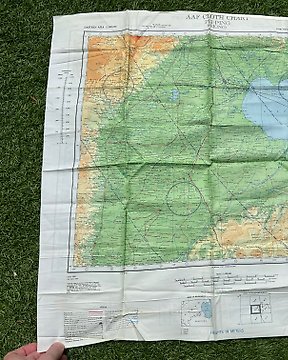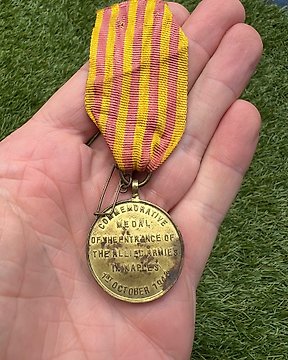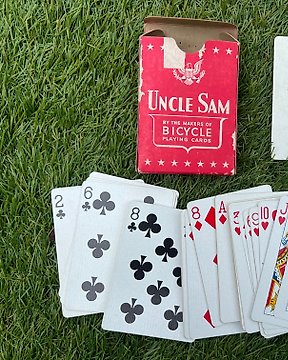Parfait; très bien emballé.
Übersetzung ansehenVereinigte Staaten von Amerika - WW2 US Army Wollpullover mit hohem Kragen – GI – Ardennen – Winter - Militäruniform - 1944
Nr. 85330909





Nice 100% original WW2 US Army Wool ''High Neck Sweater', complete, as introduced from 1942 onwards. The label dates this sweater to december 1944. A rare piece of kit that has been used in the war, so some wear is present but overall in fine condition, please look carefully at the photos. The label is still present and in nice condition. Would look great on a US WW2 winter mannequin for example!
The High Neck Sweater, introduced in 1942, ultimately replaced two older sweaters; the turtle neck and V-neck models. An extended stand-up collar, and button-up front, allowed it to posses the necessary versatility to supplant multiple sweater types. Buttoned up, it provided protection and warmth well above the neck line, or in less severe weather could be unbuttoned to regulate body temperature. The collar could also be folded back to a more relaxed position if desired. Designated type 1, the first high neck sweaters were produced under specification PQD 111B, dated 11 April 1942. Other sweaters produced under the 111B specification included a V-neck style, designated type 2, and a sleeveless design, designated type 3. At this time the turtle-neck sweater, a type issued to cold-climate troops, became limited standard and contracts ceased to be issued. By late 1942 procurement of the V-neck sweater was also terminated. This was due to the fact that the high neck sweater was proving to be a successful design, and the Army was seeking to reduce the large number of clothing items in the table of equipment with more universal types. In the fall of 1942 the Army began work on a universal winter combat uniform built on the layering principle. The high neck sweater was among the items drafted to be tested as part of the designated M-1943 experimental combat outfit. After testing was completed in 1943, the high neck sweater was to occupy a key place within the layering system of the new field uniform that was eventually adopted. In the layering scheme, the high neck sweater was worn over the coat-style wool shirt, and under the pile field jacket, or wool field jacket. During wartime production, there was little fundamental change in the high neck sweater. In early 1944 the high neck sweater was standardized along with other items originally developed as part of the then M-1943 experimental combat outfit. When this occurred, the sizing of the sweater was changed from a system of specific fitted sizes to a simplified small, medium, large, extra-large arrangement (specification PQD 111E, dated 8 February 1944). Later, after stocks of older material were used up, the color of the sweater was changed to the darker olive drab shade 33 (specification PQD 111F dated 1 January 1945), which was the color that had previously been adopted for the new woolen field uniform's jacket and trousers. Availability of materials and manufacturer's production techniques accounted for some visual differences worth noting. It was common practice to draw up specifications such that production requirements could be met despite differences in a contractor's plant equipment and manufacturing techniques. These dynamics resulted in two common variations in the sweater's appearance. One variation was manufactured using a plain jersey knit that alternated into a heavy ribbed knit when forming the cuffs and waistband. The other, a more complex design, used a ribbed knit pattern on the body and sleeves, which produced distinctive vertical ribs. A horizontal patterned weave was used to form a yoke at the top of the sweater and horizontal bands just above the cuffs and waistband. Then, the cuffs and waistband returned to a fine vertical rib knit. (Point for view of different knit patterns) . Yet another variation occurred when some sweaters were constructed in their entirety with an extremely fine yarn and weave pattern that gave them a much smoother, pattern-less appearance. Many styles of buttons with varying colors appeared on the sweater. The two most common types were a two hole button also used on undergarments, and a four hole button similar to those found on shirts, except slightly larger in size. An opaque four hole button similar to the type found on officer's clothing was also used. These types of manufacturer and material variances occurred throughout the sweater's wartime production history. The high neck sweater was made up of a few simple component parts. The neck piece consisted of a stand up collar attached to a V-shaped unit that formed the front opening, which in turn was attached to the sweater body. The two regular style sleeves were attached to either side of the sweater body. This arrangement allowed a manufacturer to produce any of the three sweater types mentioned above, e.g. either the V-neck, or high neck collar units could be fitted to the body, or the sleeves could be left off to produce the sleeveless model.
Nice 100% original WW2 US Army Wool ''High Neck Sweater', complete, as introduced from 1942 onwards. The label dates this sweater to december 1944. A rare piece of kit that has been used in the war, so some wear is present but overall in fine condition, please look carefully at the photos. The label is still present and in nice condition. Would look great on a US WW2 winter mannequin for example!
The High Neck Sweater, introduced in 1942, ultimately replaced two older sweaters; the turtle neck and V-neck models. An extended stand-up collar, and button-up front, allowed it to posses the necessary versatility to supplant multiple sweater types. Buttoned up, it provided protection and warmth well above the neck line, or in less severe weather could be unbuttoned to regulate body temperature. The collar could also be folded back to a more relaxed position if desired. Designated type 1, the first high neck sweaters were produced under specification PQD 111B, dated 11 April 1942. Other sweaters produced under the 111B specification included a V-neck style, designated type 2, and a sleeveless design, designated type 3. At this time the turtle-neck sweater, a type issued to cold-climate troops, became limited standard and contracts ceased to be issued. By late 1942 procurement of the V-neck sweater was also terminated. This was due to the fact that the high neck sweater was proving to be a successful design, and the Army was seeking to reduce the large number of clothing items in the table of equipment with more universal types. In the fall of 1942 the Army began work on a universal winter combat uniform built on the layering principle. The high neck sweater was among the items drafted to be tested as part of the designated M-1943 experimental combat outfit. After testing was completed in 1943, the high neck sweater was to occupy a key place within the layering system of the new field uniform that was eventually adopted. In the layering scheme, the high neck sweater was worn over the coat-style wool shirt, and under the pile field jacket, or wool field jacket. During wartime production, there was little fundamental change in the high neck sweater. In early 1944 the high neck sweater was standardized along with other items originally developed as part of the then M-1943 experimental combat outfit. When this occurred, the sizing of the sweater was changed from a system of specific fitted sizes to a simplified small, medium, large, extra-large arrangement (specification PQD 111E, dated 8 February 1944). Later, after stocks of older material were used up, the color of the sweater was changed to the darker olive drab shade 33 (specification PQD 111F dated 1 January 1945), which was the color that had previously been adopted for the new woolen field uniform's jacket and trousers. Availability of materials and manufacturer's production techniques accounted for some visual differences worth noting. It was common practice to draw up specifications such that production requirements could be met despite differences in a contractor's plant equipment and manufacturing techniques. These dynamics resulted in two common variations in the sweater's appearance. One variation was manufactured using a plain jersey knit that alternated into a heavy ribbed knit when forming the cuffs and waistband. The other, a more complex design, used a ribbed knit pattern on the body and sleeves, which produced distinctive vertical ribs. A horizontal patterned weave was used to form a yoke at the top of the sweater and horizontal bands just above the cuffs and waistband. Then, the cuffs and waistband returned to a fine vertical rib knit. (Point for view of different knit patterns) . Yet another variation occurred when some sweaters were constructed in their entirety with an extremely fine yarn and weave pattern that gave them a much smoother, pattern-less appearance. Many styles of buttons with varying colors appeared on the sweater. The two most common types were a two hole button also used on undergarments, and a four hole button similar to those found on shirts, except slightly larger in size. An opaque four hole button similar to the type found on officer's clothing was also used. These types of manufacturer and material variances occurred throughout the sweater's wartime production history. The high neck sweater was made up of a few simple component parts. The neck piece consisted of a stand up collar attached to a V-shaped unit that formed the front opening, which in turn was attached to the sweater body. The two regular style sleeves were attached to either side of the sweater body. This arrangement allowed a manufacturer to produce any of the three sweater types mentioned above, e.g. either the V-neck, or high neck collar units could be fitted to the body, or the sleeves could be left off to produce the sleeveless model.
- 640
- 14
- 2
Het object zag er keurig uit en was erg veilig verpakt. Niets meer dan lof!
Übersetzung ansehenlibro perfetto, come da descrizione ed immagini, consegna puntuale in buon imballaggio, eccellente.
Übersetzung ansehenHeel mooi boekje, goed verpakt en snel verstuurd. Bedankt!
Übersetzung ansehenNetjes verzonden en alles zoals omschreven. Heel blij mee bedankt! 👍
Übersetzung ansehensome blank and cut sheets
Übersetzung ansehenExactly, as mentioned in the description: '' NOTE: in the US section some insignia photo's were cut out (see attached photo's).'', so with photo's added. How could it possible be more clear?
Heel snel geleverd. Object was ook goed verpakt. Object zelf (kompas uit WO II) was precies zoals omschreven. Prachtig stuk.
Übersetzung ansehenPerfect!!! Thanks.
Übersetzung ansehenWell packed, send quickly. Product as shown. Recommended seller.
Übersetzung ansehenServizio ottimo e rapido😉👍🏻
Übersetzung ansehenSnel en in goede orde ontvangen. Erg mooi. bedankt.
Übersetzung ansehensnel bezorgd goed ingepakt een eerlijke verkoper
Übersetzung ansehenOttimo affare, venditore consigliato!
Übersetzung ansehenBen een aantal dagen in het buitenland. Het item werd (snel) afgeleverd bij de dochter. Kreeg geen enkele negatieve commentaar.
Übersetzung ansehenGreat seller !!!
Übersetzung ansehenGreat seller !!!
Übersetzung ansehensehr guter Zustand------hat mir auch incl. Versand und Aufgeld € 105.-gekostet
Übersetzung ansehenpakket geleverd als op de foto's.
Übersetzung ansehenHeel mooi aankoop dank U
Übersetzung ansehenFine book, quick and safe (!) delivery. Thank you!
Übersetzung ansehenTrès bel objet, envoi très rapide, vendeur à recommander. Merci.
Übersetzung ansehenGreat thanks a lot!
Übersetzung ansehenSnelle verzending, alles perfect!
Übersetzung ansehenTransaction parfaite. Expédition éclaire. Très positif
Übersetzung ansehen- 640
- 14
- 2
Parfait; très bien emballé.
Übersetzung ansehenDisclaimer
Der Umfang dieses Objekts ist ausschließlich für Sammler von militärhistorischen Objekten vorgesehen. Der Betreiber dieser Seite stellt ausschließlich die Plattform zur Verfügung, auf welcher Dritte Objekte Kaufen und Verkaufen können. Der Betreiber übernimmt keinerlei Verantwortung für die angebotenen Objekte und distanziert sich ausdrücklich von jedweder politischer oder andersartiger Haltung.
Der Umfang dieses Objekts ist ausschließlich für Sammler von militärhistorischen Objekten vorgesehen. Der Betreiber dieser Seite stellt ausschließlich die Plattform zur Verfügung, auf welcher Dritte Objekte Kaufen und Verkaufen können. Der Betreiber übernimmt keinerlei Verantwortung für die angebotenen Objekte und distanziert sich ausdrücklich von jedweder politischer oder andersartiger Haltung.









